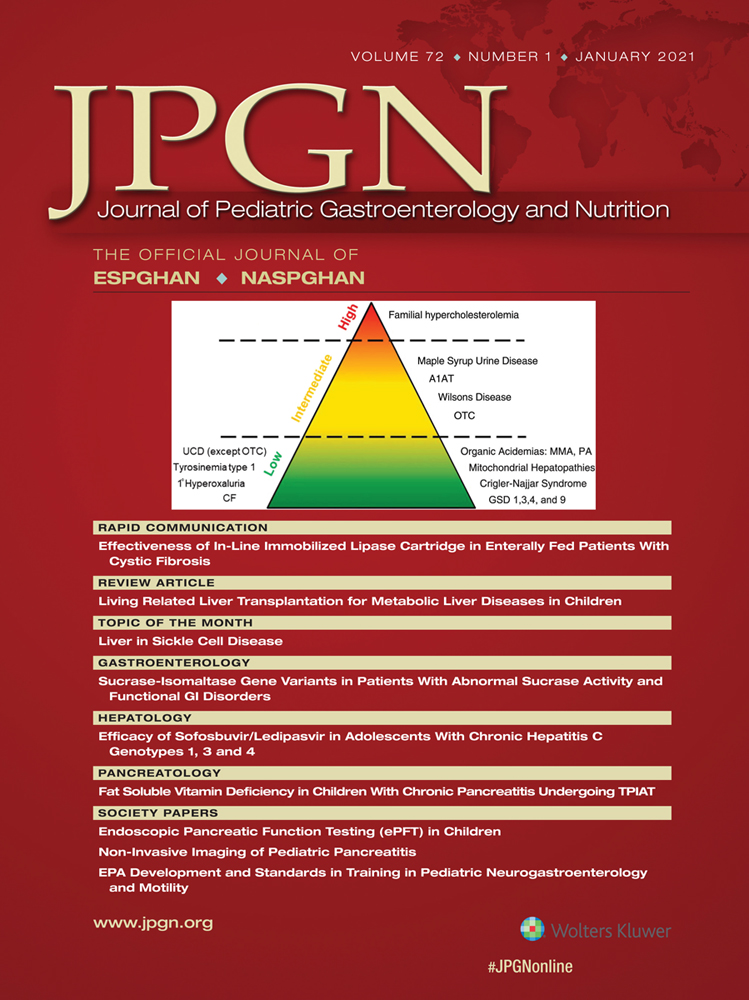Sucrase-isomaltase Gene Variants in Patients With Abnormal Sucrase Activity and Functional Gastrointestinal Disorders
Address for correspondence and reprint requests to Chirajyoti Deb, PhD, Gastroenterology Translational Research Division, Arnold Palmer Hospital Specialty Diagnostic Laboratory, 110 Bonnie Loch Ct., Orlando, FL 32806 (e-mail: [email protected]); Devendra I. Mehta, MD, Pediatriccenter for Digestive Health and Nutrition, Arnold Palmer Hospital for Children, Orlando Health, 60 Gore Street, Orlando, FL32806 and Gastroenterology Translational Research Division, Arnold Palmer Hospital Specialty Diagnostic Laboratory, 110 Bonnie Loch Ct., Orlando, FL32806 (e-mail: [email protected]).
Supplemental digital content is available for this article. Direct URL citations appear in the printed text, and links to the digital files are provided in the HTML text of this article on the journal's Web site (www.jpgn.org).
The study was funded by QOL Medical, LLC.
The authors report no conflict of interest to declare and manuscript was prepared independently from the study sponsor.
ABSTRACT
Objectives:
The aim of the study was to determine prevalence and characterize sucrase-isomaltase (SI) gene variants of congenital sucrase-isomaltase deficiency in non-Hispanic white pediatric and young adult patients with functional gastrointestinal disorders (FGIDs), and abnormal sucrase activity on histologically normal duodenal biopsy.
Methods:
Clinical symptoms and disaccharidase activities data were collected for an abnormal (low) sucrase (≤25.8 U, n = 125) activity group, and 2 normal sucrase activity groups with moderate (≥25.8–≤55 U, n = 250) and high (>55 U, n = 250) sucrase activities. SI gene variants were detected by next-generation sequencing of DNA from formalin-fixed paraffin-embedded tissues of these patients. FGIDs symptoms based on Rome IV criteria and subsequent clinical management of abnormal sucrase activity cases with pathogenic SI gene variants were analyzed.
Results:
Thirteen SI gene variants were found to be significantly higher in abnormal sucrase cases with FGIDs symptoms (36/125, 29%; 71% did not have a pathogenic variant) compared to moderate normal (16/250, 6.4%, P < 0.001) or high normal (5/250, 2.0%, P < 0.001) sucrase groups. Clinical management data were available in 26 of abnormal sucrase cases, and only 10 (38%) were correctly diagnosed and managed by the clinicians. Concomitant lactase deficiency (24%; 23/97) and pan-disaccharidase deficiency (25%; 13/51) were found in the abnormal sucrase group.
Conclusions:
Heterozygous and compound heterozygous mutations in the SI gene were more prevalent in cases with abnormal sucrase activity presenting with FGIDs, and normal histopathology. This suggests heterozygous pathogenic variants of congenital sucrase-isomaltase deficiency may present as FGIDs. Concomitant lactase or pan-disaccharidase deficiencies were common in abnormal sucrase cases with SI gene variants.




